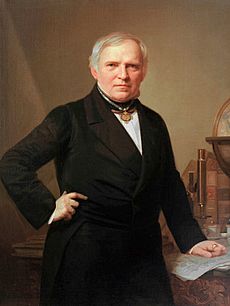Cristian Gottfried Ehrenberg facts for kids
Quick facts for kids
Christian Gottfried Ehrenberg
|
|
|---|---|

Christian Gottfried Ehrenberg
|
|
| Born | 19 April 1795 |
| Died | 27 June 1876 (aged 81) |
| Nationality | German |
| Awards | Wollaston Medal (1839) Leeuwenhoek Medal (1877) |
| Scientific career | |
| Fields | naturalist |
Christian Gottfried Ehrenberg (born April 19, 1795, died June 27, 1876) was a German scientist. He was a very important researcher in his time. He studied many different areas of science. These included natural history, zoology, and geology. He also focused a lot on microscopy. This means he used microscopes to study tiny things.
Contents
Who Was Christian Gottfried Ehrenberg?
Christian Gottfried Ehrenberg was born in Delitzsch, Germany. He grew up to be a brilliant mind. He was interested in the natural world around him. His work helped us understand many small living things. He became one of the most famous scientists of his era.
Early Life and Education
Ehrenberg started his studies in theology. This is the study of religion. But soon, his passion for science grew stronger. He then switched to medicine and natural sciences. He studied at the University of Leipzig. Later, he went to the University of Berlin. There, he earned his doctorate degree. This strong education prepared him for his future discoveries.
Exploring the Natural World
Ehrenberg loved to explore. He joined scientific expeditions. One famous trip was to Egypt and parts of the Middle East. This journey lasted from 1820 to 1825. He collected many samples of plants and animals. He also studied rocks and minerals. These trips helped him gather new information. They also gave him ideas for his later work.
Ehrenberg's Amazing Discoveries with Microscopes
Ehrenberg is most famous for his work with microscopes. He looked at tiny animals and plants. These are often called microorganisms. Before him, not many scientists studied these tiny creatures. But Ehrenberg used the best microscopes available. These tools helped him see a whole new world.
Uncovering Microscopic Life
He studied samples from many places. He looked at water from lakes and oceans. He also examined soil and rocks. He found countless tiny living things. These included bacteria, algae, and protozoa. He was one of the first to describe them in detail. He drew pictures of what he saw. These drawings were very precise.
Diatoms: Tiny Ocean Artists
One group of organisms he studied were diatoms. Diatoms are tiny, single-celled algae. They have beautiful glass-like cell walls. Ehrenberg showed how important diatoms are. They live in almost every watery place. They are a big part of the food chain. They also produce much of the oxygen we breathe. His work helped us understand their role.
Infusoria: Small Wonders
He also spent much time on "infusoria." This was a general term for many tiny aquatic organisms. He showed that many of these were not simple blobs. Instead, they were complex creatures. They had different organs and ways of moving. His research changed how scientists thought about these tiny beings.
Impact of His Work
Ehrenberg published almost 400 scientific papers. His books and articles were very important. They showed the incredible diversity of microscopic life. His work laid the foundation for microbiology. This is the study of very small living things. He proved that microorganisms are everywhere. They are in water, soil, and even the air.
His discoveries helped other scientists. They learned about the hidden world around them. His detailed observations were very valuable. He helped us understand how life works on a tiny scale.
Later Life and Legacy
Christian Gottfried Ehrenberg continued his research throughout his life. He taught at the University of Berlin. He also worked at the Berlin Academy of Sciences. He received many awards for his contributions. These included the Wollaston Medal. This is a very important award in geology.
Ehrenberg died in Berlin in 1876. His work left a lasting impact. He showed the world the importance of tiny life forms. Today, scientists still use his ideas. His legacy lives on in microbiology and geology.

